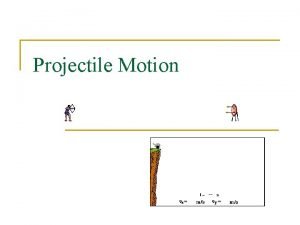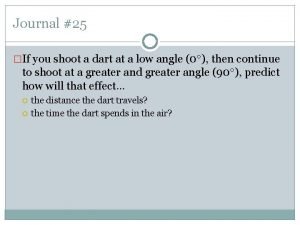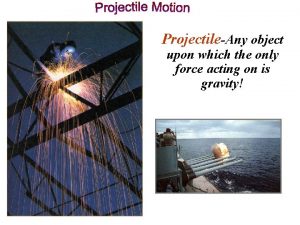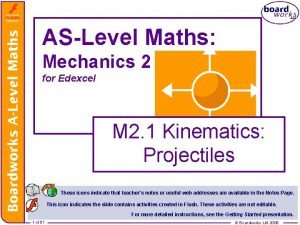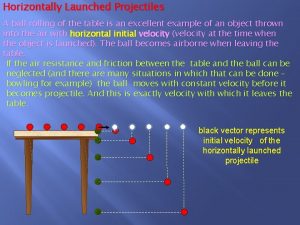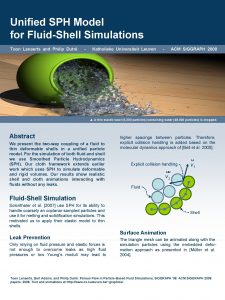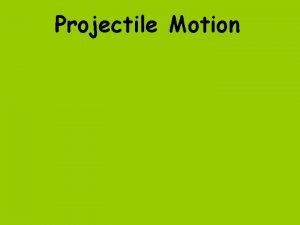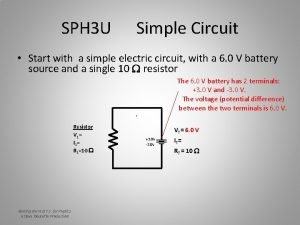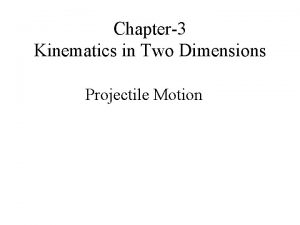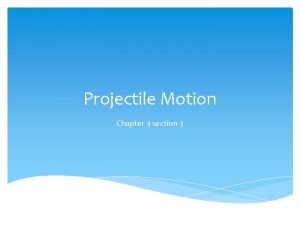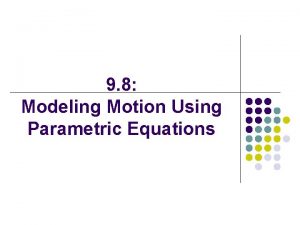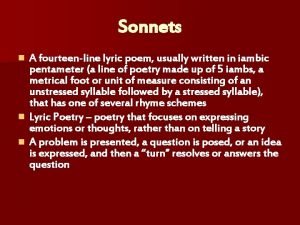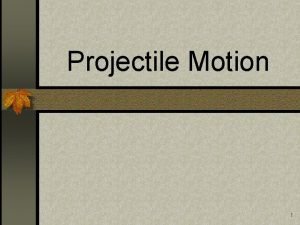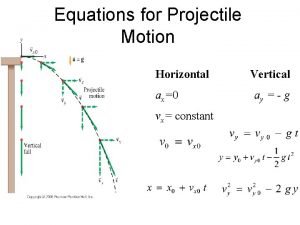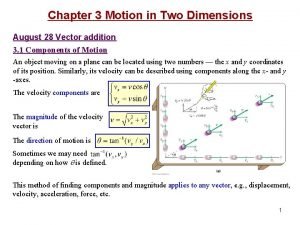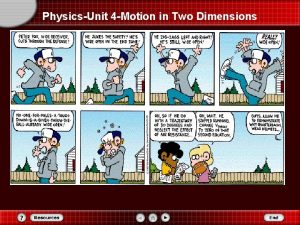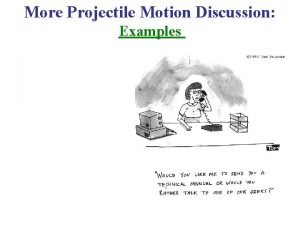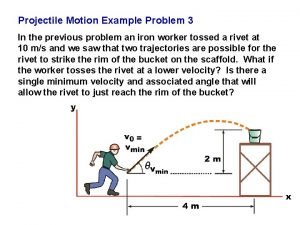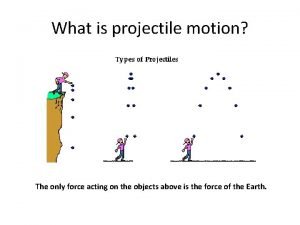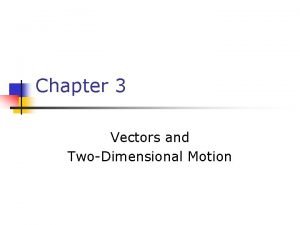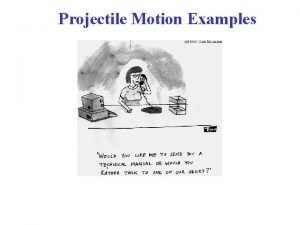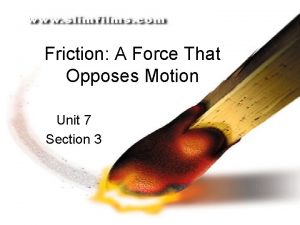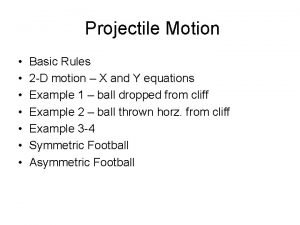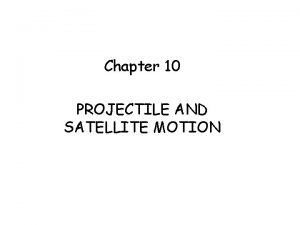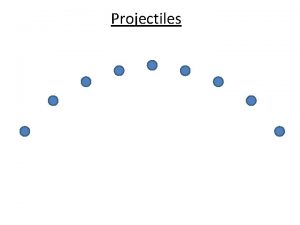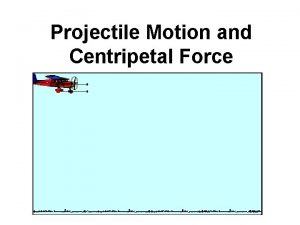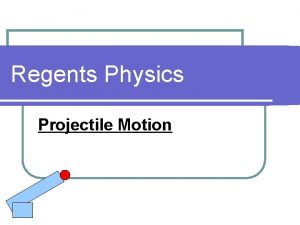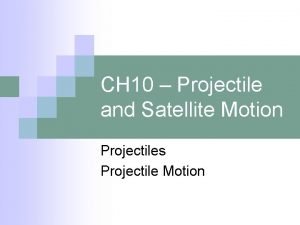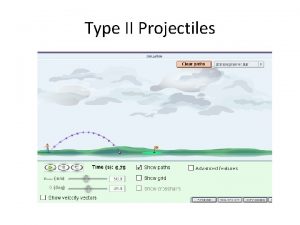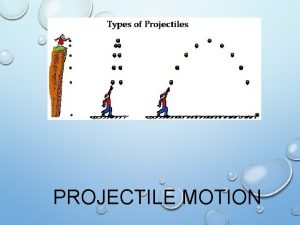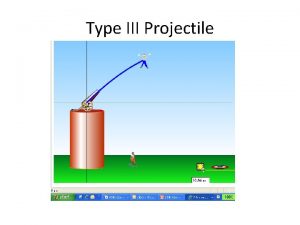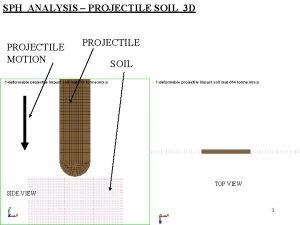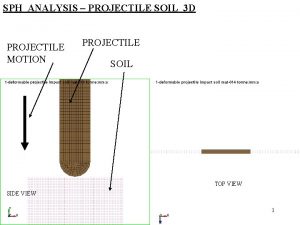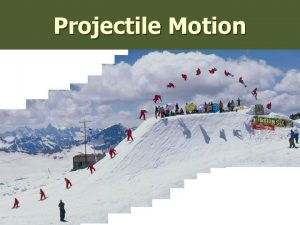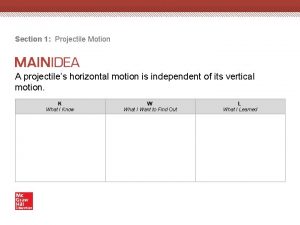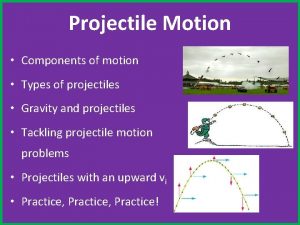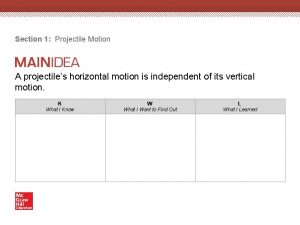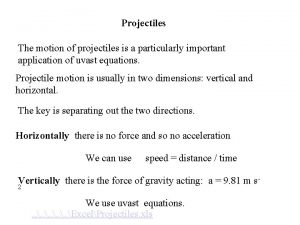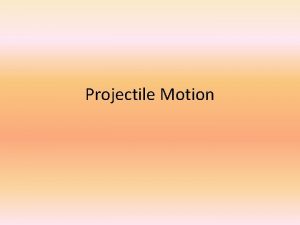Projectile Motion SPH 4 U Projectiles A projectile








![Example 1: The Cliff A ball is launched at 15. 0 m/s [right] from Example 1: The Cliff A ball is launched at 15. 0 m/s [right] from](https://slidetodoc.com/presentation_image/05f86119b6017645ab53a518496279e6/image-9.jpg)
![Example 1: The Cliff A ball is launched at 15. 0 m/s [right] from Example 1: The Cliff A ball is launched at 15. 0 m/s [right] from](https://slidetodoc.com/presentation_image/05f86119b6017645ab53a518496279e6/image-10.jpg)


































- Slides: 44

Projectile Motion SPH 4 U

Projectiles A projectile is an object on which the only force acting is gravity. It is said to be “in free fall” even if part of its motion is upward.

Projectiles A projectile may also be travelling horizontally while falling if its initial (launch) velocity had a horizontal component.

Parametric Equations As the vertical motion is accelerated any horizontal motion is not accelerated, the components are calculated separately:

Parametric Equations As the vertical motion is accelerated any horizontal motion is not accelerated, the components are calculated separately: Vertical acceleration is –g. Horizontal acceleration is zero.

Parametric Equations As the vertical motion is accelerated any horizontal motion is not accelerated, the components are calculated separately:

Parametric Equations As the vertical motion is accelerated any horizontal motion is not accelerated, the components are calculated separately: Note that the variable common to both sets of equations is Dt.

The Parabola Note that the path (or “trajectory”) of a projectile will therefore be parabolic.
![Example 1 The Cliff A ball is launched at 15 0 ms right from Example 1: The Cliff A ball is launched at 15. 0 m/s [right] from](https://slidetodoc.com/presentation_image/05f86119b6017645ab53a518496279e6/image-9.jpg)
Example 1: The Cliff A ball is launched at 15. 0 m/s [right] from the top of a 15. 0 m tower. How far does the ball travel horizontally before it lands?
![Example 1 The Cliff A ball is launched at 15 0 ms right from Example 1: The Cliff A ball is launched at 15. 0 m/s [right] from](https://slidetodoc.com/presentation_image/05f86119b6017645ab53a518496279e6/image-10.jpg)
Example 1: The Cliff A ball is launched at 15. 0 m/s [right] from the top of a 15. 0 m tower. How far does the ball travel horizontally before it lands? First, find the time it takes the ball to fall 15. 0 m:

Example 1: The Cliff First, find the time it takes the ball to fall 15. 0 m:

Example 1: The Cliff First, find the time it takes the ball to fall 15. 0 m:

Example 1: The Cliff First, find the time it takes the ball to fall 15. 0 m:

Example 1: The Cliff First, find the time it takes the ball to fall 15. 0 m:

Example 1: The Cliff Now find the horizontal distance travelled in 1. 75 s:

Example 1: The Cliff Now find the horizontal distance travelled in 1. 75 s:

The Initial Velocity If the initial velocity is not parallel or perpendicular to the horizontal, it must be broken down into its horizontal and vertical components:

The Range A ball is launched from ground level with an initial velocity of v 1 at an angle q with the horizontal. How far does the ball travel horizontally before it lands?

The Range A ball is launched from ground level with an initial velocity of v 1 at an angle q with the horizontal. How far does the ball travel horizontally before it lands? Note that the answer to this question will not be a number but an algebraic expression.

The Range

The Range We can discard this solution.

The Range Substituting into the equation for horizontal distance:

The Range Substituting into the equation for horizontal distance:

The Range Substituting into the equation for horizontal distance: (by trig identities)

The Range The advantage of deriving a general expression instead of calculating a number is that you can see the relationships between the variables. Ex. So a projectile on the moon, with 1/6 the gravity, will travel 6 times further.

The Range The advantage of deriving a general expression instead of calculating a number is that you can see the relationships between the variables. Ex. So a projectile on the moon, with 1/6 the gravity, will travel 6 times further. If the launch velocity is doubled, the projectile will travel 4 times further.

The Range You can also find maxima and minima: Which launch angle will give you the maximum horizontal distance?

The Range You can also find maxima and minima: Which launch angle will give you the maximum horizontal distance? The maximum value of sin 2 q is 1.

The Range You can also find maxima and minima: Which launch angle will give you the maximum horizontal distance? The maximum value of sin 2 q is 1.

The Range However, the expression only applies to objects launched from ground level. It can not be applied in cases such as:

Example 2: Up Off the Cliff A ball is launched at 15. 0 m/s [37 o above the horizontal] from the top of a 15. 0 m tower. How far does the ball travel horizontally before it lands?

Example 2: Up Off the Cliff A ball is launched at 15. 0 m/s [37 o above the horizontal] from the top of a 15. 0 m tower. How far does the ball travel horizontally before it lands?

Example 2: Up Off the Cliff

Example 2: Up Off the Cliff

Example 2: Up Off the Cliff

Example 2: Up Off the Cliff

Example 2: Up Off the Cliff Note that the ball stayed in the air longer and travelled further when launched slightly above the horizontal.

Example 2: At the Bottom What was the ball’s impact velocity?

Example 2: At the Bottom What was the ball’s impact velocity? Note that it is not zero upon impact. It is only zero after impact, after the ground has exerted a normal force on it to stop it.

Example 2: At the Bottom What was the ball’s impact velocity? Note that we still need to find the time first.

Example 2: At the Bottom What was the ball’s impact velocity? 11. 98 m/s 19. 37 m/s

Example 2: At the Bottom What was the ball’s impact velocity? 11. 98 m/s 19. 37 m/s

Example 2: At the Bottom What was the ball’s impact velocity? 11. 98 m/s 19. 37 m/s

More Practice Textbook Questions • p. 46 #3, 5 • p. 50 #9, 10 Tomorrow: “Projectile Motion Lab”
 Tigershark projectiles
Tigershark projectiles When an object is horizontally launched its motion
When an object is horizontally launched its motion Higher physics projectiles
Higher physics projectiles A machine fired several projectiles
A machine fired several projectiles What is type of path traveled by a projectile
What is type of path traveled by a projectile A projectile is any object upon which the only force is
A projectile is any object upon which the only force is Projectiles a level maths
Projectiles a level maths Horizontally launched projectiles
Horizontally launched projectiles How to calculate projectile motion
How to calculate projectile motion Which best describes why projectiles move in a curved path?
Which best describes why projectiles move in a curved path? Ohsu sph
Ohsu sph Sph toons
Sph toons Sph surface tension
Sph surface tension Sph 4 inches
Sph 4 inches Netgear sph
Netgear sph Sph cah toa
Sph cah toa Sph +3
Sph +3 Hsao mwd
Hsao mwd Projectile motion
Projectile motion What is vyf in physics
What is vyf in physics Projectile motion ap physics
Projectile motion ap physics Projectile motion is combination of
Projectile motion is combination of Range formula physics
Range formula physics Vertical velocity
Vertical velocity Horizontal range of projectile
Horizontal range of projectile A fourteen line lyric poem
A fourteen line lyric poem Six sigma catapult challenge
Six sigma catapult challenge Mythbusters projectile motion
Mythbusters projectile motion Motion equations
Motion equations Projectile motion
Projectile motion Objects that exhibit projectile motion follow a path.
Objects that exhibit projectile motion follow a path. Horizontal projectile motion formula
Horizontal projectile motion formula Non symmetric projectile motion
Non symmetric projectile motion Projectile motion
Projectile motion Projectile motion review
Projectile motion review Example of projectile motion
Example of projectile motion Projectile motion equations
Projectile motion equations Projectile motion definition
Projectile motion definition The only force acting on a projectile
The only force acting on a projectile Non-projectile motion
Non-projectile motion Projectile motion examples
Projectile motion examples A force that opposes motion of a projectile
A force that opposes motion of a projectile Wesbury college
Wesbury college Projectile motion rules
Projectile motion rules Chapter 10 projectile and satellite motion tossed ball
Chapter 10 projectile and satellite motion tossed ball

